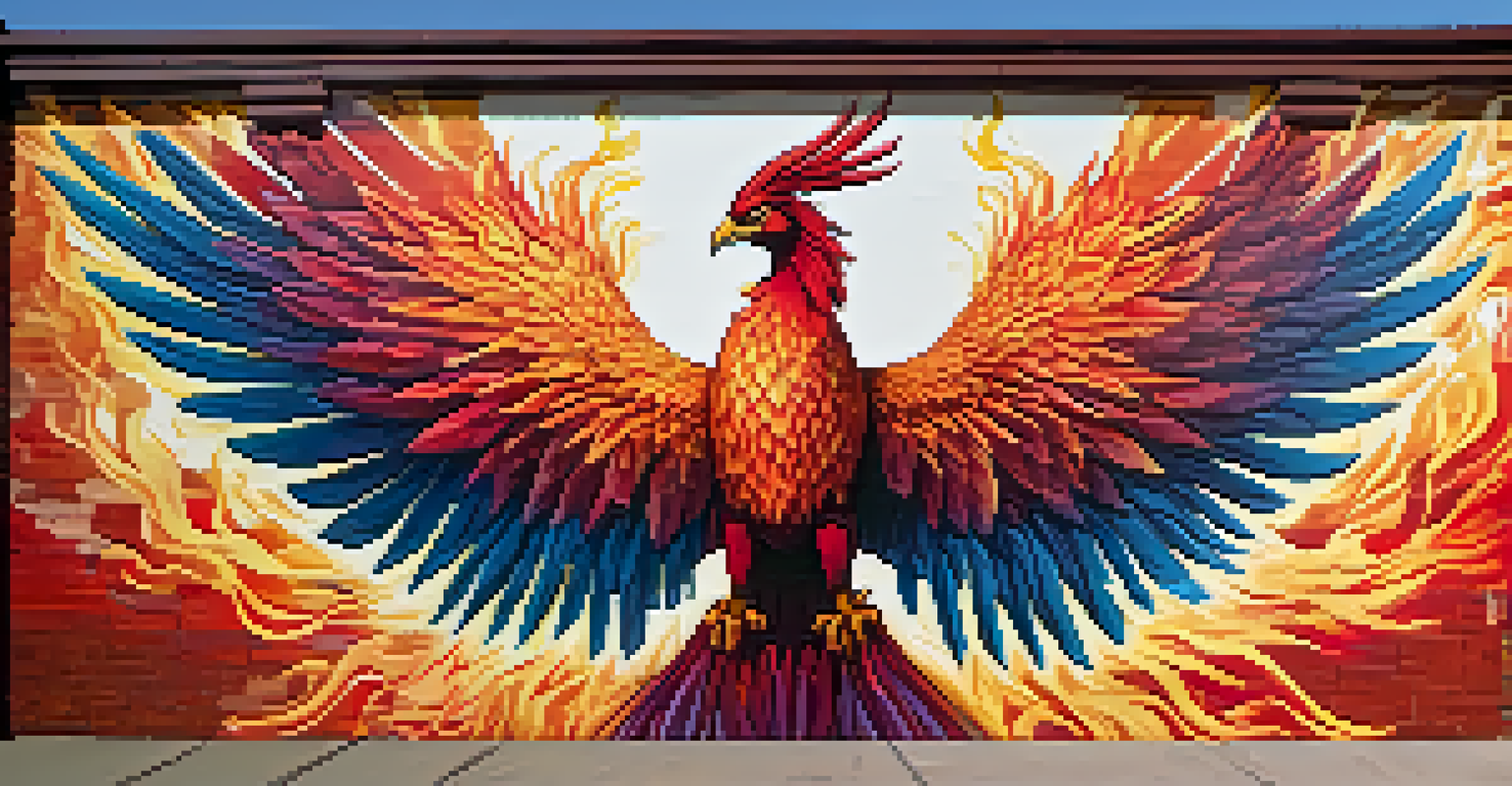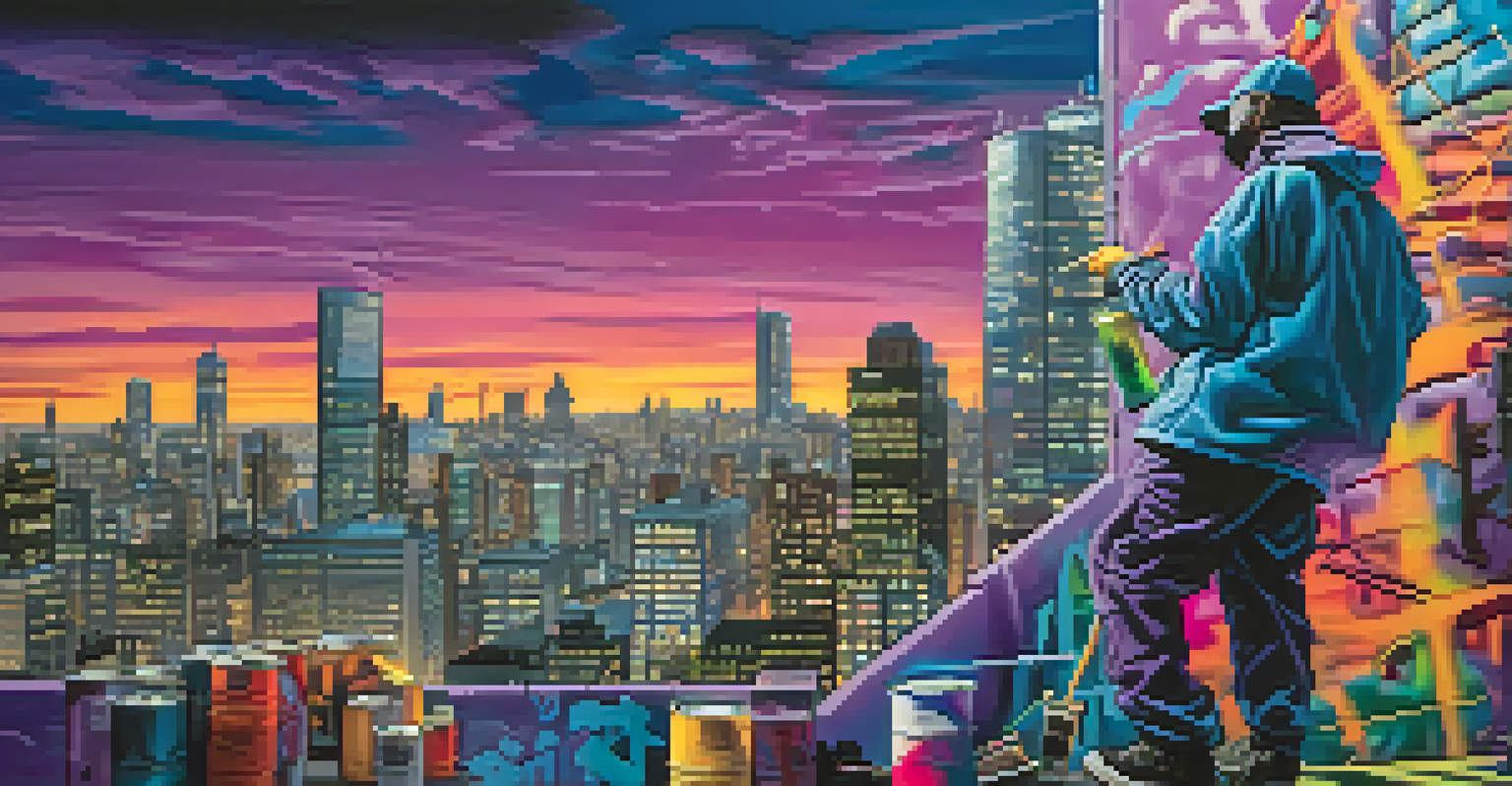Artistic Techniques: Street Art Compared to Graffiti Styles

Understanding Street Art: A Broader Perspective
Street art encompasses various artistic expressions found in public spaces. It often includes murals, stencils, and installations that engage with the community. Unlike traditional graffiti, which may focus on tagging, street art aims to convey a message or provoke thought.
Art should comfort the disturbed and disturb the comfortable.
Artists like Banksy and Shepard Fairey have popularized street art, using it as a platform for social commentary. This art form invites viewers to reflect on societal issues and can transform neglected urban areas into vibrant galleries. Street art often blurs the lines between artistry and activism, making it a powerful tool for change.
The techniques used in street art can range from spray painting to wheat-pasting and even digital projections. This diversity allows artists to express their creativity in unique ways that resonate with audiences. Overall, street art serves as a canvas for cultural expression, challenging the norms of conventional art.
Defining Graffiti: The Roots of a Subculture
Graffiti, often seen as a rebellious art form, has its roots in the urban landscape. It primarily consists of stylized writing, often referred to as 'tags,' and can be found on walls, trains, and other surfaces. While some view graffiti as vandalism, many artists see it as a legitimate form of self-expression.

The graffiti culture exploded in the late 20th century, particularly in cities like New York. Artists such as Jean-Michel Basquiat and Keith Haring brought graffiti into the mainstream, showcasing the artistic potential of what was once considered mere tagging. This shift helped to elevate graffiti to a respected art form.
Street Art as Activism
Street art serves as a powerful medium for social and political commentary, engaging the public in meaningful dialogue about pressing issues.
Graffiti techniques vary widely, ranging from simple spray paint tags to intricate murals. Artists often use a blend of colors and styles to create striking visuals that capture attention. While graffiti can sometimes carry negative connotations, its rich history is rooted in community and expression.
Comparing Techniques: Tools and Materials Used
Both street art and graffiti employ similar tools, but their techniques can differ significantly. Spray paint is the most common medium for both forms, but street artists may also use brushes, stencils, and even digital tools. This variety allows street artists to create detailed, large-scale pieces that often tell a story.
The walls are my canvases and the streets are my galleries.
On the other hand, graffiti artists tend to focus on lettering and styles that emphasize their unique tags. They may utilize markers, rollers, and even homemade devices to achieve specific effects. The emphasis on style and technique is a hallmark of graffiti culture, with artists constantly pushing the boundaries of their craft.
Understanding the materials is key to appreciating the differences between these two forms. Street artists often prioritize aesthetics and message, while graffiti artists may focus on personal expression and identity. This distinction highlights the diversity within urban art.
Themes and Messages in Street Art
Street art often conveys powerful social and political messages, making it a form of visual activism. Artists use their work to comment on issues such as inequality, environmental concerns, and human rights. This ability to engage the public in meaningful dialogue is one of the defining features of street art.
For instance, many street artists have responded to current events with poignant murals that capture the spirit of their communities. These works can inspire hope, provoke thought, and even spark movements. Street art is not only about aesthetics; it's about creating a connection between the artist and the audience.
Graffiti's Evolving Styles
Graffiti has transformed over the decades, showcasing diverse styles influenced by local culture and continually pushing artistic boundaries.
The themes explored in street art can vary widely, from playful and whimsical to deeply serious and introspective. This range allows artists to express their individuality while also addressing universal human experiences. In essence, street art becomes a reflection of society itself.
Graffiti Styles: The Evolution of Tagging
Graffiti styles have evolved over the decades, with each era introducing new techniques and trends. From the early days of simple tags to the intricate styles seen today, graffiti has become a dynamic and ever-changing art form. Artists continually innovate, pushing the boundaries of what can be done with spray paint.
Different cities have developed their own unique styles, influenced by local culture and history. For example, the bubble letters and wildstyle seen in New York differ from the sharp, geometric forms popular in Europe. This regional diversity adds richness to the graffiti landscape and allows artists to express their cultural identities.
Understanding these styles helps to appreciate the skill involved in graffiti. Artists must master their techniques while also finding ways to stand out among a sea of competitors. This constant evolution keeps graffiti fresh and exciting, ensuring its place in the urban art scene.
Public Perception: Acceptance vs. Rejection
The public perception of street art and graffiti can be quite polarized. While some view street art as a legitimate form of artistic expression, others see it as vandalism. This tension often leads to debates about the value of art in public spaces and the rights of artists to create freely.
Graffiti, often associated with crime and defacement, faces even more scrutiny. Many cities have implemented strict laws to combat tagging, viewing it as a nuisance rather than an art form. However, there is a growing movement advocating for the recognition of graffiti as a cultural expression deserving of respect.
Polarized Public Perception
The acceptance of street art and graffiti varies widely, leading to ongoing debates about their value and the rights of artists in public spaces.
As urban art continues to gain visibility, the lines between acceptance and rejection may blur. Public galleries and festivals celebrating street art are becoming more common, inviting wider appreciation. This shift reflects a changing attitude toward urban art and its potential to enrich communities.
The Future of Street Art and Graffiti
As technology advances, the future of street art and graffiti is likely to evolve in exciting ways. Digital tools and augmented reality are beginning to influence how artists create and share their work. This integration of technology could open new avenues for expression and interaction with audiences.
Moreover, the rise of social media has allowed artists to reach broader audiences, showcasing their work beyond local communities. Platforms like Instagram have become essential for artists to share their creations and connect with fans. This digital presence can amplify the impact of their messages and foster a global dialogue.

Ultimately, the future of street art and graffiti will depend on how society continues to value creative expression in public spaces. As conversations about art, culture, and community evolve, these art forms will likely adapt and thrive, reflecting the ever-changing urban landscape.